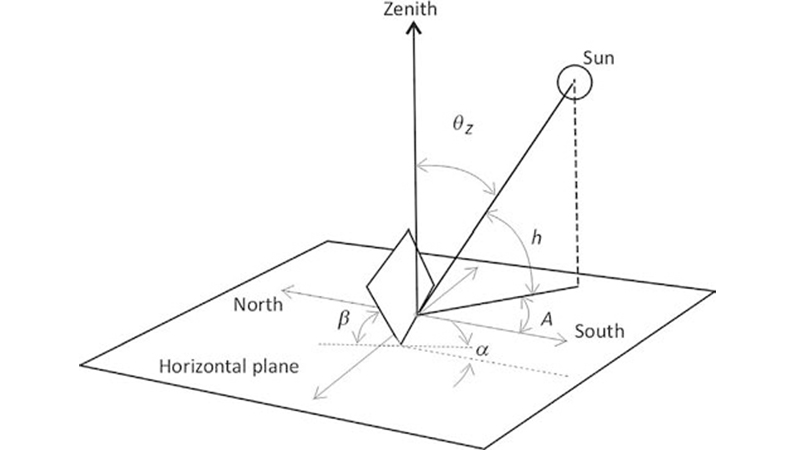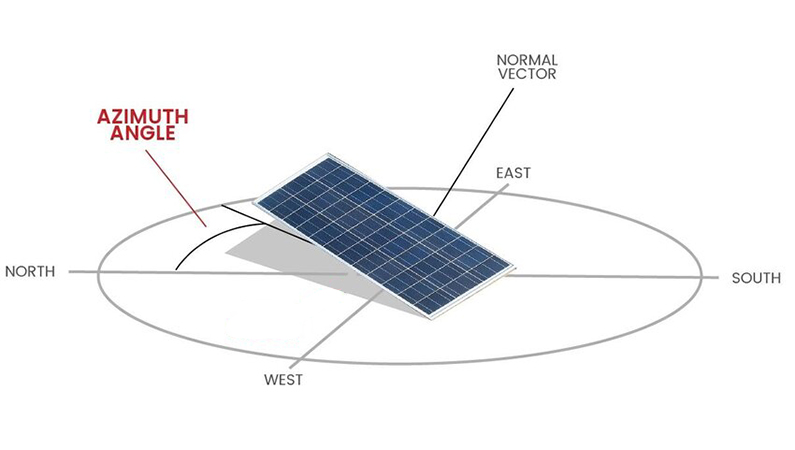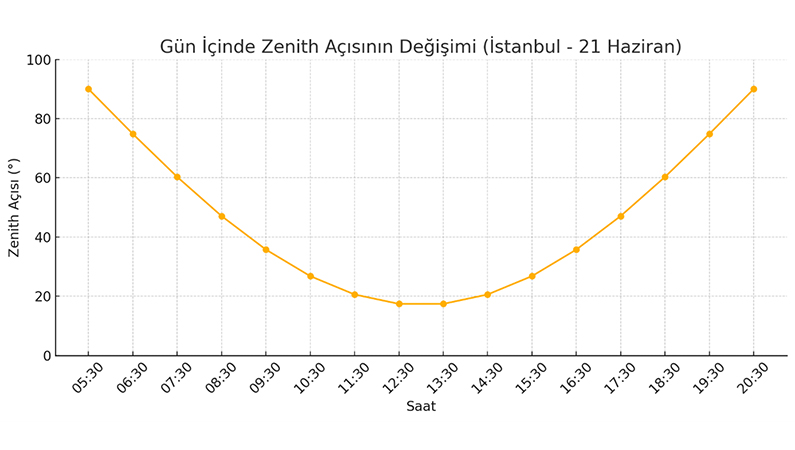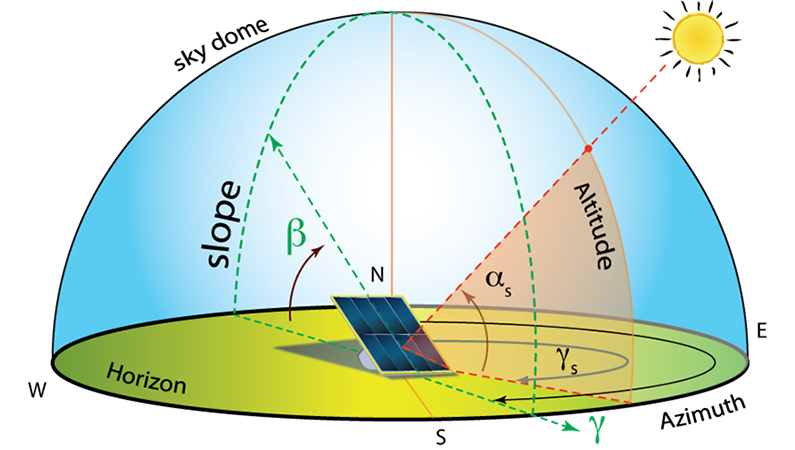Solar Power Plants (SPP) are a renewable energy source. Among these energy sources, SPPs are among the most common and environmentally friendly systems. However, the efficient operation of a SPP project is directly related not only to the panel quality but also to the zenith, azimuth and altitude angles where the panel is positioned.
Therefore, in this article, we will technically answer the questions of what are zenith, azimuth and altitude angles in SPP sites and why are they important?
What is the Zenith Angle?
The zenith angle is an important angle that indicates the position of the sun in the sky. Technically:
Zenith Angle = 90° – Sun Altitude
This angle determines the degree to which the sun’s rays are perpendicular to the ground. When the sun is directly overhead (zenith point), the zenith angle is 0°. The zenith angle increases as the sun approaches the horizon. The zenith angle never exceeds 90° because this is when the Sun is directly over the horizon. After sunset, the GHI or POA approaches zero and the zenith angle is technically undefined.
Importance of Zenith Angle in SPP Systems
- It determines how perpendicular the sun’s rays are to the panel surface.
- Efficiency directly depends on the zenith angle.
- As the angle increases, the rays come more horizontally and energy loss may occur.
- The zenith angle data is taken as reference in the annual or seasonal tilt settings of the panels. In this way, the panels are kept in a position to receive the sun’s rays in the most efficient way.

The position of the sun in the sky: Solar azimuth (A), altitude (h) and zenith (θz) angles, surface declination (β) and orientation (α)
- Surface tilt (β) (tilt angle): Indicates how much the panel is tilted relative to the horizontal. 90° for a vertical panel, 0° for a horizontal panel.
- Orientation (α) (orientation): The direction the surface of the panel faces. Measured clockwise from north (usually 180° for a south-facing panel).
What is the Altitude Angle?
The altitude angle is defined as the right angle that the sun makes with the horizon plane. It means:
- When the sun is directly overhead: Altitude angle = 90°
- When the sun is just rising or setting over the horizon: Altitude angle ≈ 0°
This angle varies depending on the time of day, time of year and geographical latitude where the SPP is located.
Importance of Altitude Angle in SPP Systems
- The steeper the angle at which the solar panel receives the sun’s rays, the more energy it produces.
- Taking the altitude angle into account, the tilt of the panels is adjusted in fixed systems.
- In solar tracker systems, the altitude angle is used to determine how the position of the panel will change throughout the day.

Azimuth Angle in Solar Panels
What is the Azimuth Angle?
The azimuth angle indicates the direction of the sun in the horizontal plane. In other words, it is the angle of the direction in which the sun is located, measured clockwise with reference to north. The general assumption is as follows:
- North = 0°
- East = 90°
- South = 180°
- West = 270°
Which direction the SPP panels face, i.e. the azimuth angle of the panel, determines how much sunlight the panel receives during the day.
Importance of Azimuth Angle in SPP
- Incorrect azimuth setting leads to efficiency losses such as shadowing and low radiation.
- The direction where the panels will be placed and the slope of the land should be planned according to this angle.
- With the correctly adjusted azimuth angle, the solar panel receives sunlight in the most efficient way throughout the day.
Frequently Asked Questions (FAQ)
- Are the zenith and azimuth angle fixed?
No, they are not. They change depending on the movement of the sun during the day and year. Therefore, tracker systems constantly monitor and optimize these angles.
- How does the zenith angle change during the year?
The Zenith angle changes seasonally according to the position of the sun in the sky. In summer the angle is lower because the sun is higher, and in winter the angle is higher because the sun is lower.
- How does the zenith angle change during the day?
In the morning, at sunrise, the sun is very close to the horizon. In this case the zenith angle is large, close to 90 degrees.
At noon, the sun reaches its highest position in the sky. The zenith angle decreases to a minimum. If the Sun is directly overhead (for example at certain times of the year around the equator), the zenith angle is 0 degrees. At other latitudes it is usually a few degrees (depending on location and season).
In the evening, as it approaches the horizon, the zenith angle increases again, reaching about 90 degrees, the same as in the morning. When the sun sets, the zenith angle is not technically defined for an invisible source, but it is again close to maximum just before setting.

As a result, zenith, azimuth and altitude angles at SPP (Solar Power Plant) sites are critical to accurately analyze the direction and intensity of solar radiation. When these angles are analyzed correctly, system performance increases, investment return period is shortened and sustainable energy production is guaranteed. For efficient energy production, these data must be measured and monitored accurately. At this point, it is of great importance to use reliable solar monitoring and measurement systems.
For those looking for precise and durable measurement equipment in SPP projects, the products offered by Seven Sensor offer a powerful solution.
